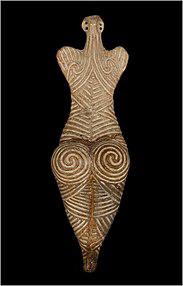Neolithic Goddess
The Great Goddess hypothesis theorizes that, in Palaeolithic, Mesolithic, and/or Neolithic Europe and Western Asia and North Africa, a singular, monotheistic female deity was worshipped.

As evidence from archaeology, thousands of artifacts from Neolithic Europe have been discovered, mostly in the form of female figurines, and a goddess theory was formulated.[clarification needed] The leading historian was Marija Gimbutas, whose interpretation is the subject of great controversy in archaeology due to her many inferences about the symbols on artifacts.[6]
Some researchers think that the symbols used for representing femininity are the rhombus for fertility and the triangle for fecundity.[7] The cross, symbolizing nature's power of fertility and renewal, was sometimes used to represent masculinity as well as the phases of the moon.[8]
